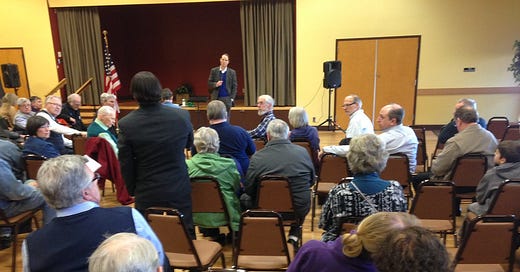Two Cheers for Kotek and Courtney: Time for Participatory Budgeting in Oregon
The Legislature's leaders are right to embrace experimentation.
Do your part to Sustain the Way!
30 Oregonians have gotten us to $2,610 - keep the momentum going so we can hire a part time editor.
Will you send $20?
Donate here or subscribe below to create a part-time editor position.
Kevin Frazier edits The Oregon Way. He attends the UC Berkeley School of Law and is a proud graduate of the UO. Before grad school, he worked for the state government and Google.

How should the Oregon Legislature invest $2.6 billion?
The traditional approach would pit urban and rural, Democratic and Republican officials in a fight over every dollar and cent. Each side would pitch some moonshot idea, one likely to result in more studies and reviews than benefits to Oregonians. Something would eventually make it through the logjam and one side would feel left out, less willing to engage down the road, and distrustful of the process as a whole.
Thankfully, Senate President Peter Courtney and House Speaker Tina Kotek are breaking with the traditional way of doing things. Their plan is to give a fraction of the $2.6 billion in funds—$240 million—to the legislators themselves to invest in their respective districts, which amounts to $4 million to each State Senator and $2 million to each State Representative.
These investments won’t be entirely willy nilly. There will be some limits on how these funds can be spent: for instance, standards imposed by the source of the funds—the American Rescue Plan, and guidelines set by the Legislative Fiscal Office. Still, a bipartisan group of legislators, inlcuding House Republican Leader Christine Drazan, have celebrated the opportunity to give power to the people by bringing state dollars closer to the communities in need.
When deciding how to select investments in their districts, legislators should lean on participatory budgeting—basically Shark Tank for community investments.
This isn’t a new idea. Several cities, such as San Francisco, have experimented with participatory budgeting. The Participatory Budgeting Project (PBP) defines this process as “a democratic process in which community members decide how to spend part of a public budget. It gives people real power over real money.” Oregon legislators should use this strategy to invest their allotment of the American Rescue Plan.
In practice, participatory budgeting is relatively straight forward. PBP outlines five key steps to follow:
These steps give community members several opportunities to get involved. They can serve on the steering community. They can brainstorm projects to pitch to the community. They can vote on their favorite projects. And, they can help make the selected projects become realities.
Unsurprisingly, this approach to investing funds has numerous benefits. For one, participatory budgeting can increase civic engagement. Additionally, it can build stronger relationships between the people and the public and private sectors. What's more, it can spur broader political participation. And, finally, new community leaders can emerge through this process.
This is the sort of community-based governing that makes democracy thrive. If our Senators and Representatives commit to following the will of the people, to launching a participatory budgeting process, and to seeing that process through, then a whole new approach to getting stuff done can emerge in Oregon.
***********************************
Keep the conversation going:
Facebook (facebook.com/oregonway)
Twitter (@the_oregon_way)
Reach out to Kevin:
@kevintfrazier




